SAMUEL GREEN
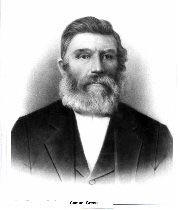
Samuel
Green
was born 28 October 1831 in Claverley,
Shropshire, England, the son of William Henry Green and Mary Bennett. He was their first
child. The town of Claverley is a beautiful town of
half-timbered buildings. The parish church of Claverley is an
ancient one, and has an interesting series of wall paintings of
five pairs of knights on horseback, which dates back to about
1200. A Saxon font which dates to the late 7th
century is found in the church, along with a Norman font.
Claverley was owned by Leofric, Earl of Mercia, whose wife, Lady
Godiva, is associated with the famous legend.
Other
children,
John, Mary, and Hannah were born in Claverley. William Henry
worked as a laborer, so he had to move the family from town to
town to find work. Melissa Green Manwill states in her history
of William Henry Green: The Green family started shifting
around to find employment, first in Gloucestershire and
Staffordshire. At an early age Samuel and John shifted for
themselves, seeking employment. Later they joined their
father. William Henry and wife had already heard the
missionaries and were anxious to have the two boys home with
them so they could all embrace the gospel at the same time.
They were all baptized on January 11, 1850. Mary Bennett
was baptized in 1849." (Life of John Green)
Samuel was 19 years old when he was baptized. Other records show
that Mary Bennett Green was the first to be baptized, on 17
September 1849, then Samuel's sister Mary in 1849, then William
on 28 October 1850, then Samuel and John on 5 November 1851.
In
1852 the family prepared to travel to Utah to gather with the
Saints. The trip was eventful: Arriving at Liverpool,
William deposited 6,000 shillings to pay for their
transportation to America. After making all arrangements, they
were told that the sea was rough and dangerous and that no
ships would sail before the middle of January. The only thing
William could do was rent a small place and wait. The Green
family was assigned to sail on the Ellen Maria,
but the Captain informed them that only Samuel would be able
to go. Having no desire to sail alone, Samuel sold his ticket
to another passenger and he remained to travel with his dear
family.
The
Green
family boarded the Elvira Owen in February 1853. The passenger
list showed:
Born Age Origin
Green, Mary 1796 57 Worchester
Green, William 1810 43 Worchester occupation: Labourer
Note: BMR, p. 106
Green, Samuel 1832 21 Worchester
Green, John 1835 18 Worchester
Green, Mary 1839 14 Worchester
Green,
Hannah
1842
11
Worchester
Address of the William Henry
Green family, January 28, 1853, as recorded on the ship's
register was: M. Rowan, Worcester, Worcestershire, England.
In
the emigration records of Liverpool is found the following: Wm.
Green, age 43, served in the British Army in Company E,
Address McRowan St. Watford, Worcester; Mary, his wife, age
57; Samuel, son, age 21; John son, age 18; Mary, daughter, age
14; Hannah, daughter, age 11.
The
Millennial
Star reported: Under the direction of Joseph W. Young, who
had presided over the Preston Conference, a company of three
hundred and forty-five Saints sailed from Liverpool on the
fifteenth of February, 1853, on board the ship Elvira Owen. On
the twenty-third of March, 1853, after a most speedy voyage
lasting only thirty-six days, the Elvira Owen arrived at the
bar at the mouth of the Mississippi River. Three births, three
marriages and three deaths occurred during the voyage. There
were a few cases of small-pox, which, however, it did not
prove fatal, and the disease did not spread to any great
extent. Captain Owen treated the Saints with much kindness,
especially the sick, and a memorial, expressive of their
gratitude for his fatherly conduct to all, was presented to
him by the passengers. After being detained at the bar several
days the Elvira Owen was towed up the river, and the emigrants
landed in New Orleans on the thirty-first of March. Proceeding
up the Mississippi River the emigrants arrived in Keokuk on
the thirteenth of April, being two days short of two months
from Liverpool, which was considered an extraordinarily rapid
journey. (Millennial Star, Vol. XV, pp. 154, 288 and
361)
The
next
part of the voyage was difficult: On March 23, 1853 after a
speedy voyage, lasting only 36 days, the ship arrived at the
bar at the mouth of the Mississippi. The trip across the vast
span of water was far from being pleasant. The Green family,
along with others, were frightened and seasick from the
rocking of the ship and the violent waves dashing over the
deck. Food and fresh water must be taken along. One pint of
drinking water a day was allowed each person. All cooking was
done in a small room on deck, then the food had to be carried
down the ship ladder to the family members below. There were
daily prayers for guidance and safety.
John
Brown,
the Church agent in charge of emigrating Saints welcomed the
family: After being detained for several days, the vessel
was towed up the River, landing in New Orleans the 31st day of
March. Proceeding up the river they arrived at Keokuk on April
13, being two days short of being two months since leaving
Liverpool. This was considered an extraordinarily rapid
journey. While journeying, Brother John Brown told the Green
family about the beautiful Utah Valley, with its groves of
cottonwood trees and sparkling streams of fresh water. "It
would be an ideal spot to call home", said Elder Brown. While
making necessary preparations for the long trek across the
Plains, the Green family pitched their tents at Montrose,
Iowa. When everything was in readiness, they started the trek
into the wilderness. The morning they left, the sun was
shining full strength overhead. This was the morning of July
11, 1853. Some of the Company came under the provision of the
Ten Pound Company, and some by the Perpetual Emigration Fund.
The Greens came by the Ten Pound Company.
The
company
list for the Cyrus Wheelock Company shows:
William Henry Green
Mary Bennett Green
John Green
Mary Green Jr.
Hannah
Green
A study of the passenger list of
the ship "Elvira Owen" and that of the Cyrus H. Wheelock Company
indicates that the 345 Saints who left Liverpool, England,
February 12, 1853, stayed together as a whole and made up the
bulk of the 396 members of the Cyrus H. Wheelock Company. The
William Henry Green family made the journey, although the name
of Samuel Green is not included in the Cyrus H. Wheelock Company
passenger list. It is not known how Samuel Green reached the
Great Salt Lake Valley. There is some evidence, however, that he
did arrive with his family. (History of the William Henry
Green Family)
The
Company
had 17 horses, 2 mules, 216 oxen, 83 cows, 12 heifers, 52
wagons, and one carriage. The family walked the 1500
miles, and arrived in the Salt Lake Valley on October 16, 1853.
The
family
rested in Salt Lake for a short time, then traveled south to
help settle Pleasant Grove,
Utah. The Fort had just been completed, and the family
lived inside the Fort in their covered wagon. Later a one-room
house was built inside the Fort Square.
1855
was
a difficult year: Mid-summer promised a bounteous harvest,
but with the return of the crickets, coming in a cloud and
eating every blade of green grass there was, discouragement
ran high. By the time these pests were destroyed, the crops
were also destroyed. The family lived on sego, thistle
and red-root.
At
26 years old, Samuel Green married Pamelo Wishaw, who was then
17 years old. They had sixteen children. Eight children grew to
maturity: Samuel James, William Henry, Charles Edward, Mary
Ella, Herman, Joseph Erving, Alfred Ray, and Susie Josephine.
Samuel and Pamelo built a two-story
soft-rock house near the south and east walls of the
then-abandoned Grove Fort. This home is now listed on the
National Register of Historic Homes.
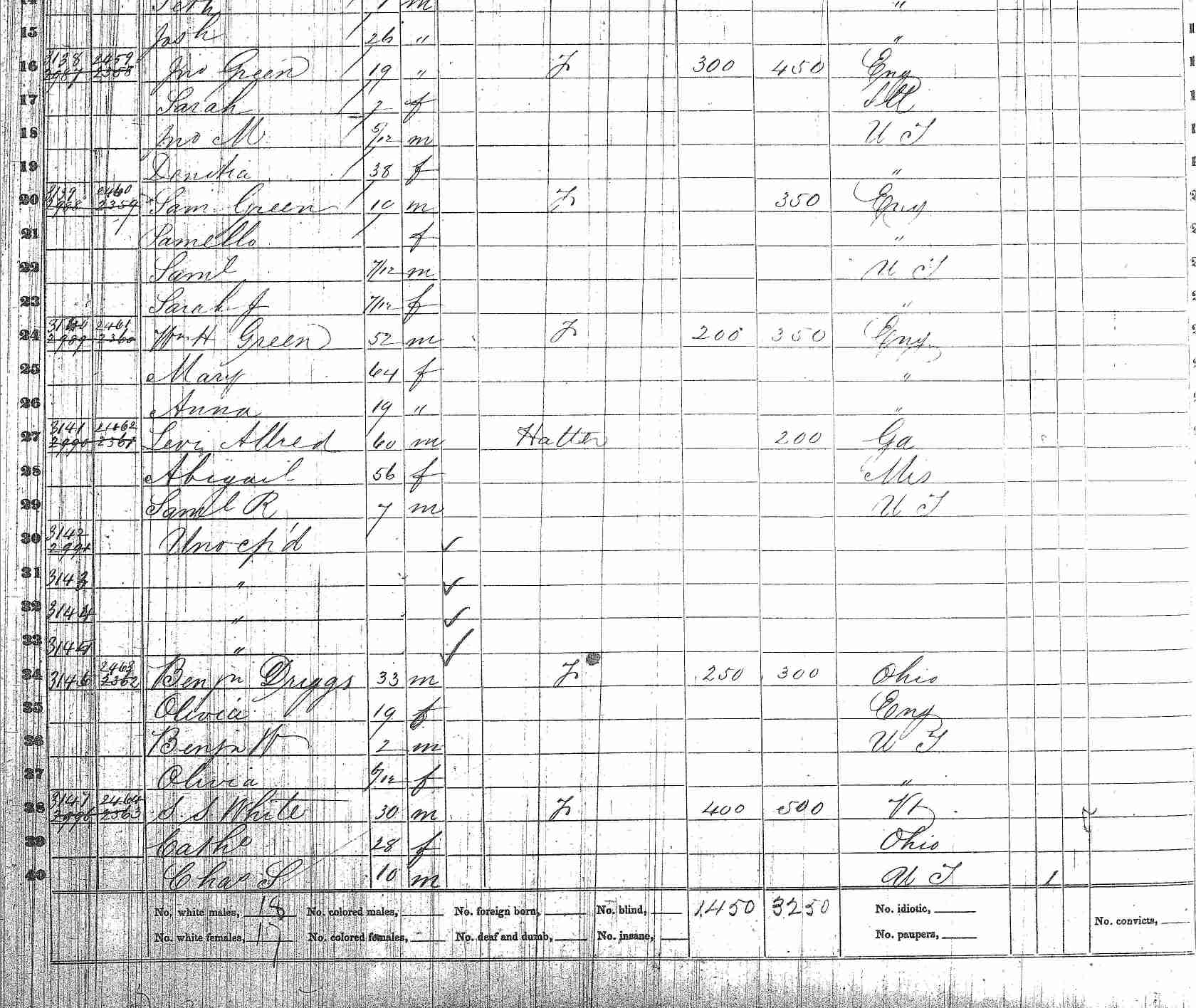
1860 census, Pleasant Grove (Battle Creek), Utah County, Utah
Samuel
Green's
family became inadvertently involved in the Black Hawk War in
1863. William H. Seegmiller tells of the battle at Pleasant
Grove, Utah: "On the evening of April 12, 1863 we camped at
Pleasant Grove, Utah County. We had been camped but a short
time when a band of Indians, probably fifty, under the
leadership of Little Soldier, came to our camp and inquired if
we were Americats. We answered no, and he then asked if we
knew where the Americats were camped; we told them that we did
not know. They then said: "We find them." They passed on down
the street towards the center of town. Some of Brigadier
General Connor's command from Fort Douglas were in town...Soon
we heard a loud report and learned that Connor's men had found
out that the Indians were coming for them, and had shot a
Howitzer, a small cannon, at them as they were turning south
to where the soldiers were located. We were informed that the
soldiers went to Samuel Green's house on the east side of the
road and asked the people to leave, which they did in a hurry.
The soldiers then went into the house, pulled their cannon in
with them, pulled up some of the floor and got under it,
leaving their wagons in the road and their mules and horses
were in a corral on the west side of the street. The Indians
dared not follow the troops into the house, but shot into it
through the door and window, peppering the back wall with
bullets. When the Indians saw they could not successfully rout
the soldiers or kill them, they turned their attention to
booty. But when the soldiers saw they were going to lose their
horses they fired a charge of grape shot from their cannon
into the corral at their animals, preferring to kill them to
letting the Indians get them. They killed and maimed some; the
Indians got those not hurt and loaded them with blankets and
supplies, and struck for the mountains very much pleased with
their success." Some sources say this battle took place at
the home of John Green, Samuels brother.
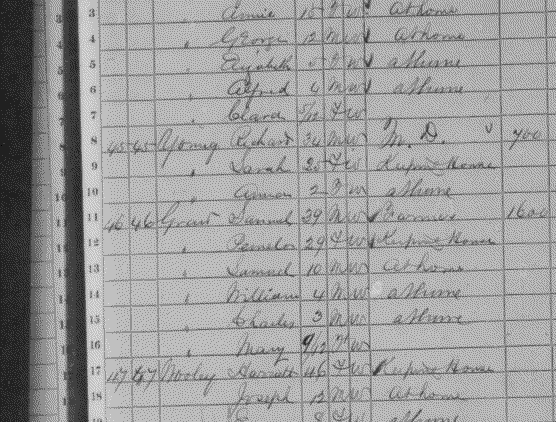
1870 census, Pleasant Grove, Utah, Utah
Samuel
Green
was a hard-working man, and became one of the prosperous farmers
of Pleasant Grove. Timpanogos Town describes Samuel
Green as "a farmer who brought forth some of the biggest
crops per acre in fertile Utah Valley". Samuel worked for
the Utah Sugar Company as a Utah County field agent for many
years. Samuel Green was an elected member of the Pleasant Grove
City Council. He was ordained a High Priest and was an active
Church member.
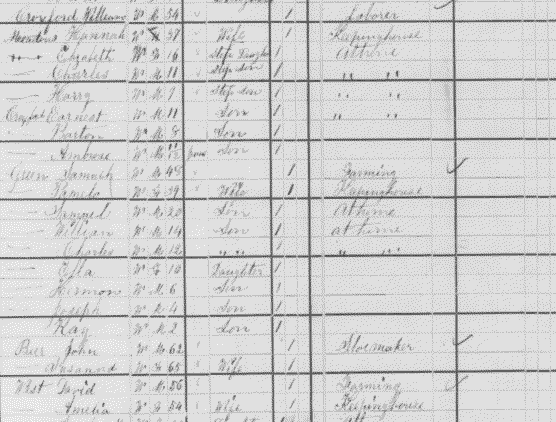
1880 census, Pleasant Grove, Utah
In
The History of William Henry Green Samuel is described: Those
who remember Samuel Green recall him as a man who stood
upright, had square shoulders, was of medium height and of
slender appearance. His hair was heavy and ruddy brown. He
wore a full beard and mustache. Samuel Green was a quiet man
and a thinker, but not a conversationalist; two stories from
out of his life describe his personality. At one time the
family grocery account at the Pleasant Grove Mercantile was
getting rather high in the mind of the proprietor, William L.
Hayes. It was the custom for townsfolk to charge the few items
they had to buy at the store from one harvest season to
another, and then settle the account as cattle "came off" the
mountain or the yield of the farms was "in". The Green family
followed this practice. William Hayes spoke with Samuel Green
about the bill, to which Samuel replied, "I pay my bills."The
other incident was a remark by one of Samuel Green's
associates: "Sam Green doesn't say much, but he sure keeps up
a hell of a thinking."
Samuel
enjoyed
becoming a grandfather: Samuel Green and Pamelo Wishaw
enjoyed their family. They were hospitable and generous with
their grandchildren. Grandpa Green is remembered as having
favored little girls, probably because he lost so many of his
own small daughters. (History of William Henry Green)
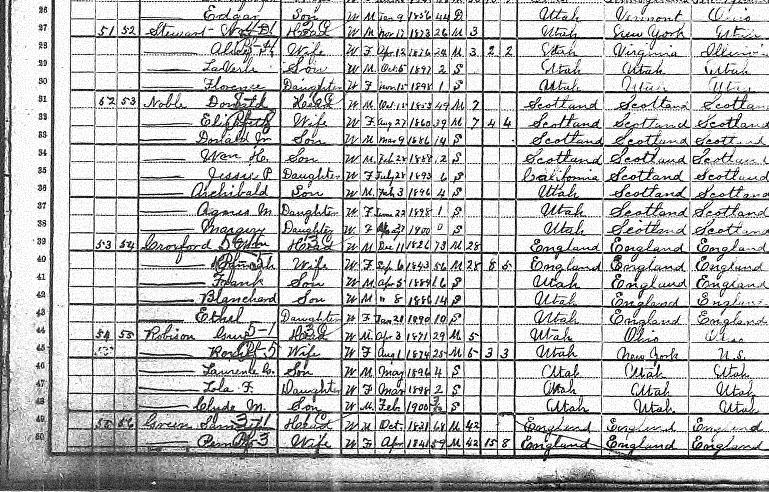
1900 census, Pleasant Grove, Utah, Utah
Pamelo
Wishaw
Green died on January 10, 1907, when Samuel Green was 75 years
old. His son, Joseph and his family moved in with him to care
for him. A family incident occurred when the family of
Joseph Green was living at the Samuel Green home to care for
the aged Grandfather. Their eldest son, a boy of about seven,
became irked at something and announced he was going to run
away from home. His absence did not cause his parents concern
until nightfall; a neighborhood hunt did not locate the boy.
Then Grandpa Green "thought like a boy" and looked under the
granary. There he found the sleeping lad. (History of
William Henry Green)
Samuel
died
when he was 78 years old: On the day before his death, Susie
Josephine Green Robison and her eight year-old son visited
Samuel Green. While standing on a chair, the little boy
recited "Little Orphan Annie" to his Grandpa, whereat the
elderly gentleman tried unsuccessfully to find a nickel in his
packet. "Come tomorrow and I'll have a nickel for you," said
Grandpa Green, but he was unable to keep his promise. At 7:20
a.m. on January 18, 1910, the 78 year-old man was sitting in a
favored kitchen chair playing with his grandchildren when
death came. (History of William Henry Green)
Samuel's obituary was printed in the Pleasant Grove News on
January 21, 1910:
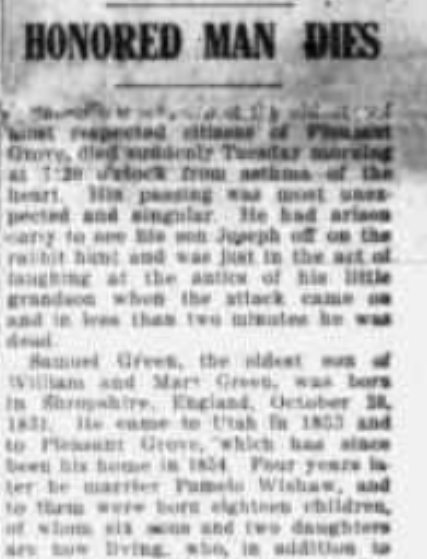
[Samuel Green, one of the most] respected citizens of Pleasant Grove, died suddenly Thursday morning at 7:30 oclock from asthma of the heart. His passing was most unexpected and singular. He had arisen early to see his son Joseph off on the rabbit hunt and was just in the act of laughing at the antics of his little grandson when the attack came on and in less than two minutes he was dead.
Samuel Green, the eldest son of William and Mary Green, was born in Shropshire, England, October 30, 1831. He came to Utah in 1853 and to Pleasant Grove, which has since been his home in 1854. Four years later he married Pamelo Wishaw, and to them were born eighteen children, of which six sons and two daughters are still living, who, in addition to fifty-seven grandchildren and five great grandchildren make a posterity of seventy souls.
His public life may be said to begin in 1864 when he went back across the plains to the Missouri river to assist immigrants to Utah. He has been active in the building of his home city, having the distinction of representing his district in the city council for eight years, first with Mayor A.G. Keetch, two terms with Mayor Jos. E. Thorne and last with Mayor J.G. Bullock.
In all those years his official duties were ably discharged. Such was the quality of his private and his public life that to all men who knew him the name or word of Samuel Green stood as synonymous for justice and integrity.
(Pleasant Grove News, 21 January 1910 on www.familysearch.org)
The
Deseret
Evening News, Tuesday, January 18, 1910, on page 8, carried the
following:
SAMUEL GREEN ANSWERS SUDDEN SUMMONS
Samuel
Green,
one of Pleasant Grove's most prominent and respected citizens,
died suddenly this morning a few minutes after 7 o'clock. He
was in his usual health, and was sitting in his chair talking
to his grandchildren when he was stricken with heart failure
and expired at once.
He
was
born October 28, 1831, at Greatbridge, Shropshire, England,
and came to Pleasant Grove in 1853 with his parents and their
family. He has taken a prominent part in the development of
the town ever since. For many years he was a member of the
City Council. Of late years he was the agent of the Utah Sugar
Company here. Six sons and two daughters survive him, besides
many grandchildren. His wife died three years ago.
The
funeral
will be held in the Tabernacle here on Thursday at 2:00 p.m.
Samuel Green was buried in the Pleasant
Grove
Cemetery.